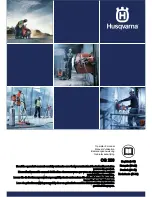
6
Protect your hearing. Wear hearing protection during
extended periods of operation. Following this rule will
reduce the risk of serious personal injury.
Inspect power tool cords periodically and, if damaged,
have repaired at your nearest Authorized Service Cen-
ter. Constantly stay aware of cord location. Following
this rule will reduce the risk of electric shock or fire.
Check damaged parts. Before further use of the power
tool, a guard or other part that is damaged should be
carefully checked to determine that it will operate
properly and perform its intended function. Check for
alignment of moving parts, binding of moving parts,
breakage of parts, mounting, and any other conditions
that may affect its operation. A guard or other part that
is damaged should be properly repaired or replaced
by an authorized service center. Following this rule will
reduce the risk of shock, fire, or serious injury.
Make sure your extension cord is in good condi-
tion. When using an extension cord, be sure to use
SPECIFIC SAFETy RULES
one heavy enough to carry the current your product
will draw. A wire gauge size (A.W.G.) of at least 14 is
recommended for an extension cord 50 feet or less
in length. A cord exceeding 100 feet is not recom-
mended. If in doubt, use the next heavier gauge. The
smaller the gauge number, the heavier the cord. An
undersized cord will cause a drop in line voltage resulting
in loss of power and overheating.
Inspect for and remove all nails from lumber before
using this power tool. Following this rule will reduce the
risk of serious personal injury.
If the power supply cord is damaged, it must be replaced
only by the manufacturer or by an authorized service
center to avoid risk.
Save these instructions. Refer to them frequently and
use them to instruct others who may use this power tool.
If you loan someone this power tool, loan them these
instructions also.







































